Meeting the needs of people living with Muscular Dystrophy
Condition
Muscular Dystrophy (MD) is a collection of more than 30 genetic and hereditary and muscular diseases involving progressive skeletal muscle weakness. A deterioration of the protein, dystrophin, causes the muscles to break down over time. Other symptoms include poor balance, frequent falls, walking difficulty, a limitation in active range of motion and respiratory difficulty.
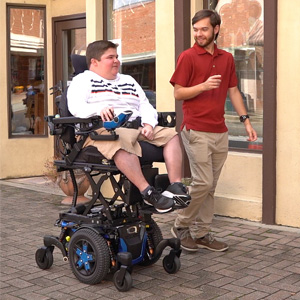
Mobility and Assistive Technology Needs
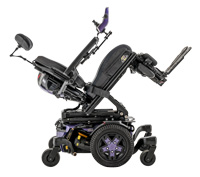
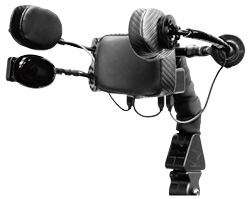
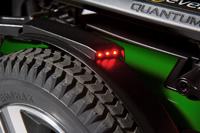
Depending on the severity and progression of the condition, some clients may not require assistive technology and may only have an affected gait. Others may only require the use of a walker or braces to accomplish independent mobility.
Once an individual shows a decreased ability in the utilization of a manual wheelchair, it is suggested that the individual be evaluated for power mobility in order to promote increased independence and continued social interaction with peers.
The client should be fitted with a power base that can meet various seating, positioning and electronics needs. A client may require a power positioning system, like power tilt and recline, to help with pressure relief or independent weight shifting. The electronics of the power base should be expandable so they can continue meeting the individual’s needs as the condition progresses.
A customized seating system is an important part of helping a client compensate for asymmetries, providing proper stability and support and managing pressure while sitting. There are also many custom accessories that can be adapted in order to meet the needs of your client. Optional LED fender lights on the Edge® 3, Edge 3 Stretto® and Q6 Edge® Z (optional on the Q6 Edge® 2.0 and Q6 Edge® HD) help clients see and be seen.
Often, clients change over time due to growth. To adapt to these changes, the seating system should be modular to grow with the client.
Another consideration for a client with MD is to be sure a power base can accept a ventilator if the requirement arises.
The Quantum® Solution
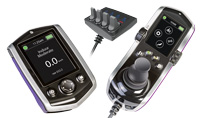
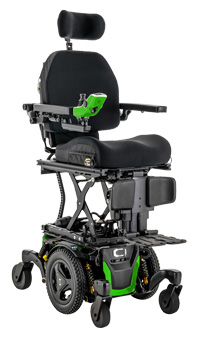
Clients with MD who have advanced mobility needs may benefit from a power base that has the ability to accept full seating and positioning options. The Edge® 3 and Edge 3 Stretto® fulfill client seating and positioning needs and are compatible with an array of drive controls. Every other chair is at least 2.5” wider than the Edge 3 Stretto®! Optional iLevel® power adjustable seat height at up to 4.5 mph, lifts clients up to 12”, promoting greater social interaction and independence. The Q6 Series also accepts a selection of seating and positioning options, and possesses a proven track record of quality, reliability and customer satisfaction. All of these power chairs have the capability to accept expandable electronics to meet the changing needs of your client.
TRU-Balance® 3 Power Tilt, Power Recline, and 12” Power Adjustable Seat Lift with iLevel® provide clients with the option of ordering angle-adjustable towers that provide dynamic seating essential to your client’s positioning, comfort, skin integrity and function within the seating system. iLevel has up to 12” of lift that can benefit your client during transfers and help maintain independence in a variety of environments.
TRU-Comfort 2 Seating provides excellent comfort and pressure management in addition to having an aesthetically pleasing look. Stealth Products® Cushions allow for added stability and support for a client’s positioning and provide exceptional envelopment for assistance with pressure management.
Q-Logic 3 Advanced Drive Controls are user-friendly and highly customizable. The Q-Logic 3 EX Joystick comes standard with wireless Bluetooth programming through Windows devices and Bluetooth access to computer, tablet and phone functions. Clinic Mode allows for quick setup of multiple input devices during client evaluations and automatically assigns drive modes to input devices. The Q-Logic 3 iAccess features programmable push button and toggle options for customized seating access.
The Q-Logic 3 EX Enhanced Display includes a learning IR and wireless Bluetooth options. Since some clients with MD may have trouble communicating, the Enhanced Display is equipped with a Bluetooth mouse emulator that can provide wireless access with wheelchair controls to a communication device to enhance your client’s communication with others. In addition, the Bluetooth feature also provides your pediatric clients with independent control of a computer mouse through their electronics so they can participate at a higher independent level with school work. The Enhanced Display also has the ability to learn infrared commands for your client to control devices like televisions and X10 technology to further improve independence.

Stealth® i-Drive®
The i-Drive® is the most advanced wheelchair drive control in the world. The drive control works at a frequency of 16kHz, which provides real time user interface and results in improved driving efficiency, better feedback, smoother control and a more intuitive “feel.” Our superior positioning and head control products produce a mechanical framework for the i-Drive technology that offers limitless combinations of head, trunk and cervical positioning options.
| Type | Onset | Symptoms | Progression |
|---|---|---|---|
| Duchenne | 2-6 years old | Increased muscle weakness, frequent falling, difficulty getting up from a sitting or lying position, a waddling gait and respiratory difficulty | Eventually affects all voluntary and breathing muscles and the heart. Survival is rare beyond the early 30s. |
| Becker’s | As late as the age of 25 | Increased muscle weakness, frequent falling, difficulty getting up from a sitting or lying position, a waddling gait and respiratory difficulty | Progresses slowly and with variability but can affect all voluntary muscles. Most with BMD survive well into mid to late adulthood. |
| Congenital | At or near birth | Generalized weakness with possible joint stiffness or looseness and a lack of muscle tone. | Typically progresses slowly. |
| Distal | Childhood to adulthood | Common weakness and wasting in the muscles of forearms, hands, lower legs and feet | Progression is slow. Typically not life threatening. |
| Facioscapulohumeral | Typically in teens or early adulthood | Forward sloping shoulders and difficulty of moving arms over the head and closing the eyes | Progression is slow. A patient typically lives a normal life span. |
| Limb-girdle | Adolescence or early adulthood | Muscular weakness that starts at the hips and moves to the shoulders, arms and legs | Progression is slow, with cardiac complications sometimes appearing later in the disease. |
| Myotonic | At birth, with more common forms beginning in teen or adult years | Muscle spasms or stiffening of muscles after use; may also affect the heart and endocrine system | Progression is slow, sometimes spanning 50 - 60 years. |
| Oculopharyngeal | 40s, 50s and 60s | Eye and facial muscle weakness; as well as difficulty swallowing and eventually leading to limb weakness | Progression is slow. |
| Emery-Dreifuss | Usually by age 10 | A rare form of the disease with muscle weakness and wasting starting in shoulders, upper arms and lower legs. Unlike other forms, muscle contractures appear before the person experiences significant muscle weakness. | Progression is slow and cardiac issues are common. |


